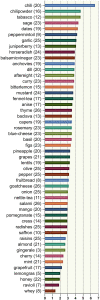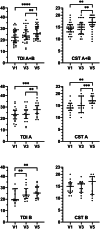Flavor education and training in olfactory dysfunction: a pilot study
- PMID: 32248300
- PMCID: PMC7286942
- DOI: 10.1007/s00405-020-05950-8
Flavor education and training in olfactory dysfunction: a pilot study
Abstract
Purpose: Olfactory training is recommended in olfactory dysfunction (OD) showing promising results. OD patients frequently ask for training modifications in the hope of a better outcome. Also, a lack of knowledge of the flavor system is evident. This investigation sought to implement flavor education (FE) and encourage patients to experience flavors in terms of a flavor training (FT).
Methods: In included patients (n = 30), OD was either of postinfectious (86.7%) or posttraumatic (13.3%) cause. Chemosensory abilities were tested orthonasally (using Sniffin Sticks = TDI) and retronasally (using the Candy Smell Test = CST). Key points of flavor perception were demonstrated in an educative session. Subjects were instructed to consciously experience flavors out of a list of 50. Effects of FT were explored in two groups (group A and B), with group B starting FT 17 weeks later.
Results: FE was appreciated and drop-out rate stayed very low (one participant). Compliance was high and 30.4 ± 12.9 flavors were tried. Overall TDI scores improved in 10 patients (6 group A, 4 group B) in a clinically significant way (> 5.5). For group A (starting FT earlier) rm-ANOVA showed a significant effect of session (timepoint) on CST (p < 0.01).
Conclusion: Flavor education is demonstrated as feasible and appreciated in a clinical setting. FT seems to be a welcomed second-line therapy in patients with olfactory dysfunction. This study shows beneficial trends of FT; however, further studies with larger sample sizes and standardized training protocols are needed.
Keywords: Anosmia; Hyposmia; Olfactory training; Quality of life; Retronasal.
Conflict of interest statement
The authors declare that they have no conflict of interest.
Figures



Similar articles
-
Retronasal olfactory function in patients with smell loss but subjectively normal flavor perception.Laryngoscope. 2020 Jul;130(7):1629-1633. doi: 10.1002/lary.28258. Epub 2019 Aug 31. Laryngoscope. 2020. PMID: 31471971 Free PMC article.
-
Long-lasting olfactory dysfunction in COVID-19 patients.Eur Arch Otorhinolaryngol. 2022 Jul;279(7):3485-3492. doi: 10.1007/s00405-021-07153-1. Epub 2021 Nov 10. Eur Arch Otorhinolaryngol. 2022. PMID: 34757458 Free PMC article.
-
Association Between Orthonasal Olfaction and Chemosensory Perception in Patients With Smell Loss.Laryngoscope. 2020 Sep;130(9):2213-2219. doi: 10.1002/lary.28773. Epub 2020 Jun 3. Laryngoscope. 2020. PMID: 32492191 Free PMC article.
-
Chemosensory function and dysfunction.Crit Rev Oral Biol Med. 1998;9(3):267-91. doi: 10.1177/10454411980090030201. Crit Rev Oral Biol Med. 1998. PMID: 9715366 Review.
-
Smell and taste disorders.Facial Plast Surg Clin North Am. 2012 Feb;20(1):93-111. doi: 10.1016/j.fsc.2011.10.011. Facial Plast Surg Clin North Am. 2012. PMID: 22099622 Review.
Cited by
-
Effect of early olfactory training on olfactory recovery after nasal endoscopy in patients with chronic rhinosinusitis and olfactory impairment.Am J Transl Res. 2022 Apr 15;14(4):2600-2608. eCollection 2022. Am J Transl Res. 2022. PMID: 35559418 Free PMC article.
-
Improving taste sensitivity in healthy adults using taste recall training: a randomized controlled trial.Sci Rep. 2022 Aug 16;12(1):13849. doi: 10.1038/s41598-022-18255-z. Sci Rep. 2022. PMID: 35974039 Free PMC article. Clinical Trial.
-
Four odorants for olfactory training are enough: a pilot study.Eur Arch Otorhinolaryngol. 2024 Dec;281(12):6445-6458. doi: 10.1007/s00405-024-08930-4. Epub 2024 Sep 6. Eur Arch Otorhinolaryngol. 2024. PMID: 39242414 Free PMC article.
-
International consensus statement on allergy and rhinology: Olfaction.Int Forum Allergy Rhinol. 2022 Apr;12(4):327-680. doi: 10.1002/alr.22929. Int Forum Allergy Rhinol. 2022. PMID: 35373533 Free PMC article. Review.
-
Statistical overview of the Sniffin' sticks olfactory test from the perspectives of anosmia and hyposmia.Sci Rep. 2025 Mar 15;15(1):8984. doi: 10.1038/s41598-025-93380-z. Sci Rep. 2025. PMID: 40089590 Free PMC article.
References
-
- Shepherd GM. Smell images and the flavour system in the human brain. Nature. 2006;444:316–321. - PubMed
-
- Aschenbrenner K, Hummel C, Teszmer K, Krone F, Ishimaru T, Seo HS, Hummel T. The influence of olfactory loss on dietary behaviors. Laryngoscope. 2008;118:135–144. - PubMed
-
- Deems DA, Doty RL, Settle RG, et al. Smell and taste disorders, a study of 750 patients from the University of Pennsylvania Smell and Taste Center. Arch Otolaryngol Head Neck Surg. 1991;117:519–528. - PubMed
-
- Hunt JD, Reiter ER, Costanzo RM. Etiology of subjective taste loss. Int Forum Allergy Rhinol. 2019;9:409–412. - PubMed
MeSH terms
LinkOut - more resources
Full Text Sources
Medical

